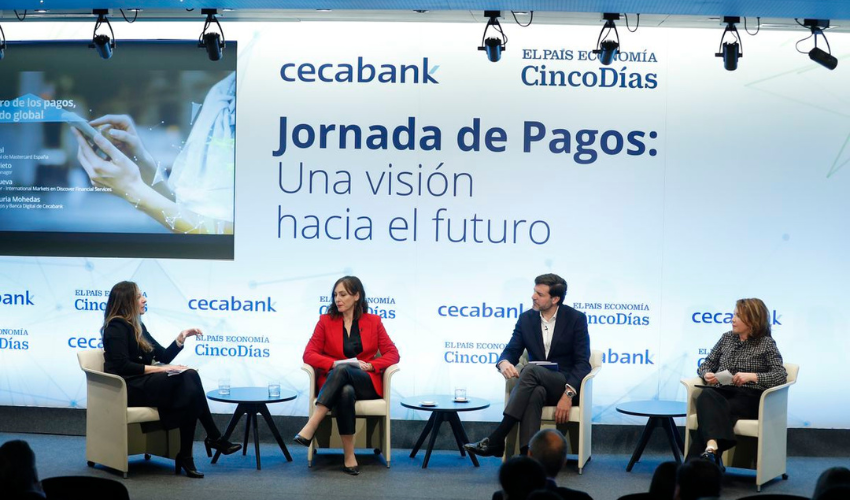Industry and banks warn at a conference organised by Cecabank and CincoDías that new financial tools must have user experience at their core

Cryptocurrencies or non-fungible tokens (NFT) are minority payment methods, but possible today thanks to technology. Technology has already changed the habits of consumers, who, when it comes to shopping, can consider whether to pay in cash, pay with a contactless card or send a Bizum. These are the three most common payment methods in Spain, a pioneer country in SEPA instant credit transfers. Almost half (48%) of every one hundred transactions processed by the Iberpay system in Spain have been conducted in this form, while other member countries have a rate of around 13%.
This omnichannel approach is the firm commitment of a sector which, in turn, is working on new methods that combine security, convenience and flow. This was the message conveyed this Friday by the financial industry, banks and payment operators during a conference organised by Cecabank and CincoDías which brought together 180 attendees from more than one hundred different organisations, inaugurated by Juan José Gutiérrez, Corporate Director of Technology Services at Cecabank, and Nuño Rodrigo, Deputy Director of CincoDías.
Any technology that wants to succeed must offer "the best usability and user experience", said Eduardo Prieto, CEO of Visa in Spain, during a round table moderated by Nuria Mohedas, Director of Payments and Digital Banking at Cecabank. Speaking at the round table, Paloma Real, CEO of Mastercard España, gave a preview of the plans of the major operators: click to pay systems with biometric authentication that simplify processes without compromising security or generating "friction" due to a hypothetical exposure of personal data.
Hence both multinationals, in addition to collaborating with (or acquiring) specialised firms, are investing heavily in security. However, compared to the potential losses generated by online fraud, the amount is derisory. The goal is to "avoid up to 30,000 million in potential losses", estimated Real. One of the most widespread methods is smishing. According to a study by Visa, three out of four people who receive a fraudulent SMS open it.
Just as important as securing processes will be offering different payment methods to both users and retailers. In the case of the former, "digital maturity" determines their loyalty when it comes to choosing how they transact, analysed the director of Payments and Digital Banking at Cecabank, Nuria Mohedas. In parallel, the industry needs to facilitate "as much as possible" the speed at which new "easy, secure and fast" payment methods are implemented in businesses, added Sara Villanueva, managing director of international markets at Discover Financial Services in Spain. Her company develops, for example, technologies such as tap on mobile, to replace traditional point-of-sale (POS) terminals with the use of a mobile phone or tablet.
The Bizum paradigm
"Bizum is a Spanish banking success story", celebrated the CEO of Cecabank, José María Méndez. With a user base of 23 million, its own CEO, Ángel Nigorra, acknowledges that the way forward is coexistence: "It is unthinkable that Bizum users will not pay with cards". The success of the A2A solution is due to its widespread acceptance within the banking community; to the support of systems such as Iberpay, Redsys or Cecabank, and to the user experience. "A phenomenon that is observed with envy in many markets", says Villanueva.
SEPA system A2A transactions cover 36 countries, 4,000 banks and 800 million European accounts, according to Iberpay. Its executive director, Juan Luis Encinas, pointed out that out of every one hundred immediate transfers made in Spain, 85% are through Bizum, which, according to Villanueva, makes Spain a "mature ecosystem with very solid foundations" in the adoption of this type of A2A or P2P systems (such as PayPal).
The high capillarity of the banking network in the territory has also favoured this scenario, as demonstrated by the EURO 6000 ATM network, which, as pointed out by its CEO, Anayansi Ramírez, is the only one present throughout all of Spain. This means that Spanish payment methods account for "a very high volume", with up to 10,000 million payment transactions last year alone, said Juan Carlos Guirado, executive director of Sistema de Tarjetas y Medios de Pago (STMP).
Guirado also mentions the entry into the sector of technological giants through their wallets (P2P wallets), such as Google Pay or Apple Pay. Even STMP itself has implemented a Buy Now, Pay Later (BNPL) solution, such as "plazox", with the aim of "improving the value chain and payment transactions".
A decade after its creation, CecaBank has become a "national and international payments hub", Méndez recalled during the closing ceremony of an event which, he hoped, would become "a benchmark" for the sector. With a portfolio of around 300 clients, Cecabank serves banks, financial institutions and the insurance sector through digital solutions, card payment transaction management and underlying asset processing. A business model that is "sustainable, solvent and with great potential" that produced a net profit of €64 million in 2022, almost double that of ten years ago (€34 million).


